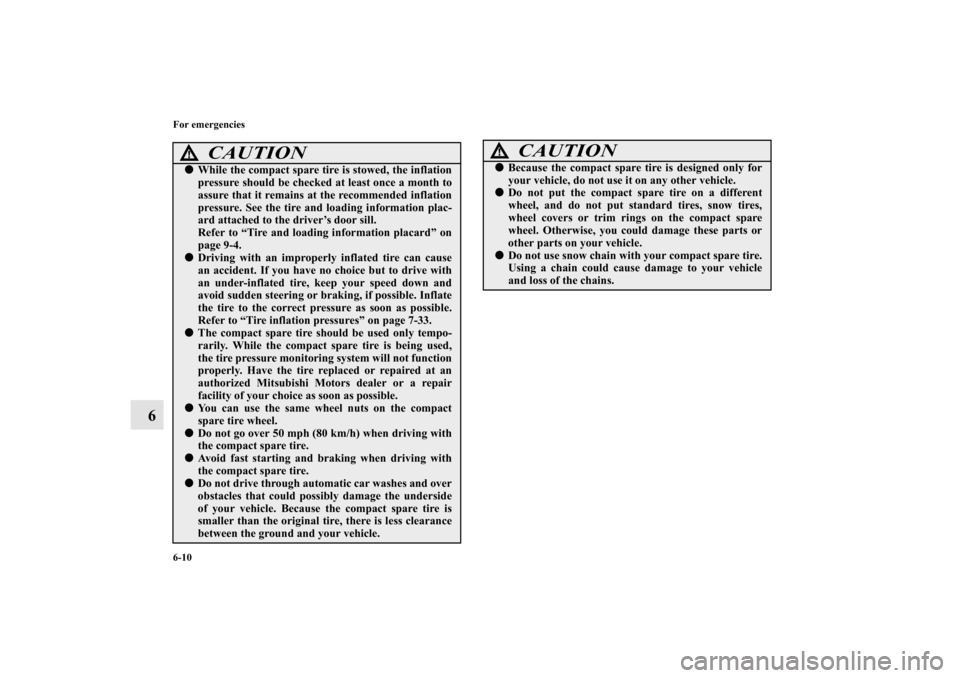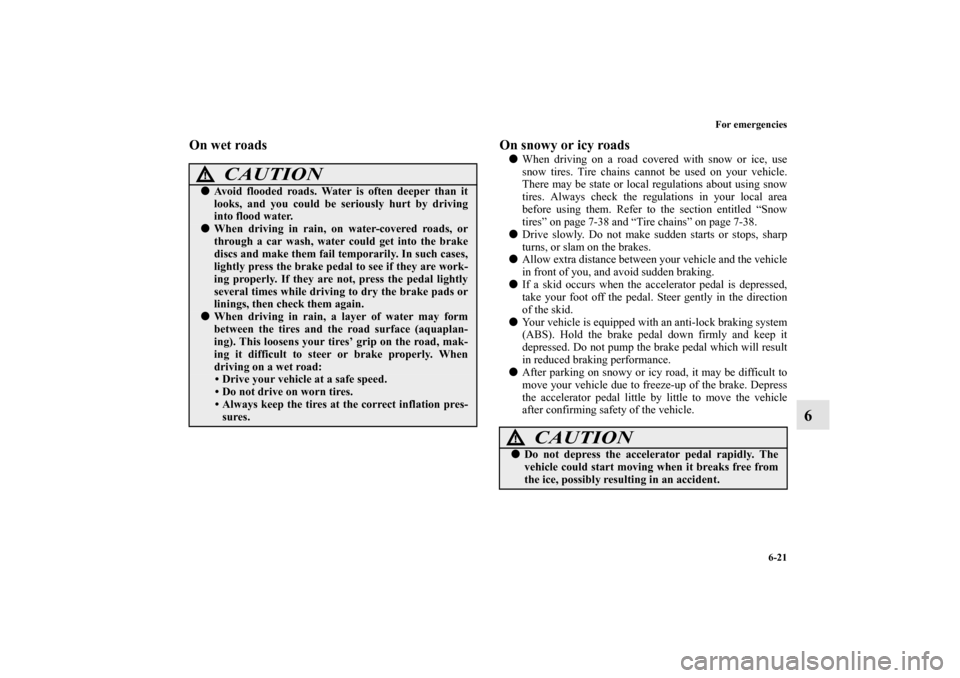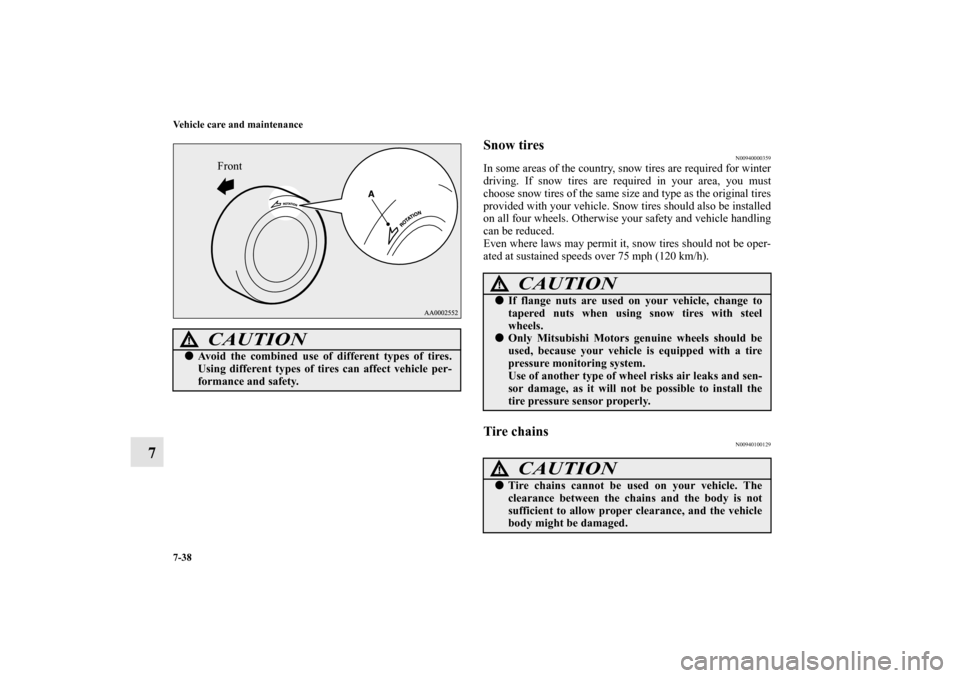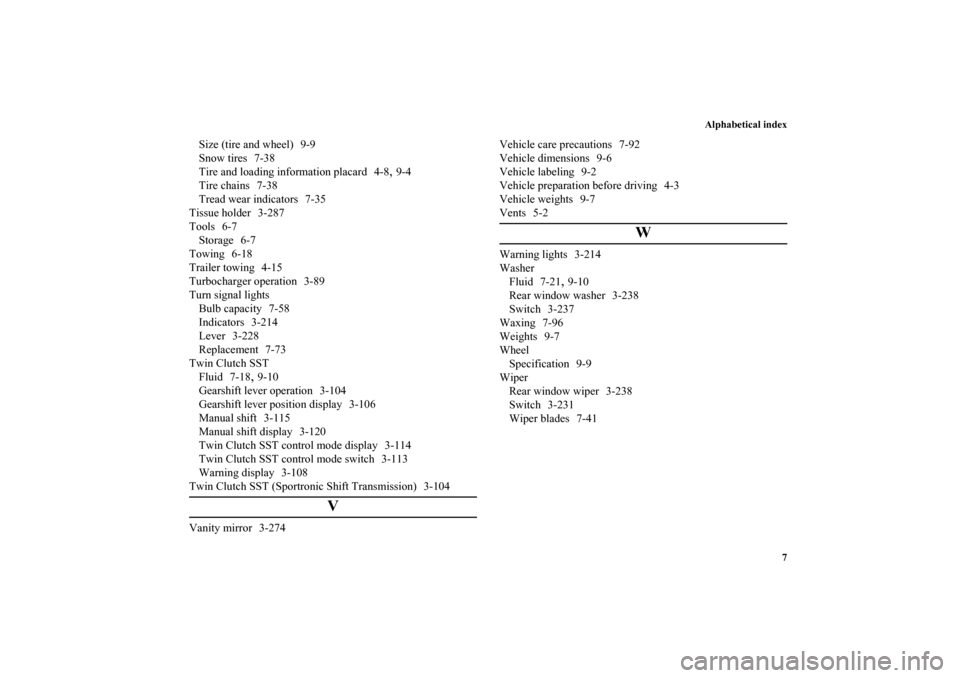Page 519 of 658

6-10 For emergencies
6
CAUTION
!�
While the compact spare tire is stowed, the inflation
pressure should be checked at least once a month to
assure that it remains at the recommended inflation
pressure. See the tire and loading information plac-
ard attached to the driver’s door sill.
Refer to “Tire and loading information placard” on
page 9-4.
�
Driving with an improperly inflated tire can cause
an accident. If you have no choice but to drive with
an under-inflated tire, keep your speed down and
avoid sudden steering or braking, if possible. Inflate
the tire to the correct pressure as soon as possible.
Refer to “Tire inflation pressures” on page 7-33.
�
The compact spare tire should be used only tempo-
rarily. While the compact spare tire is being used,
the tire pressure monitoring system will not function
properly. Have the tire replaced or repaired at an
authorized Mitsubishi Motors dealer or a repair
facility of your choice as soon as possible.
�
You can use the same wheel nuts on the compact
spare tire wheel.
�
Do not go over 50 mph (80 km/h) when driving with
the compact spare tire.
�
Avoid fast starting and braking when driving with
the compact spare tire.
�
Do not drive through automatic car washes and over
obstacles that could possibly damage the underside
of your vehicle. Because the compact spare tire is
smaller than the original tire, there is less clearance
between the ground and your vehicle.
�
Because the compact spare tire is designed only for
your vehicle, do not use it on any other vehicle.
�
Do not put the compact spare tire on a different
wheel, and do not put standard tires, snow tires,
wheel covers or trim rings on the compact spare
wheel. Otherwise, you could damage these parts or
other parts on your vehicle.
�
Do not use snow chain with your compact spare tire.
Using a chain could cause damage to your vehicle
and loss of the chains.CAUTION
!
BK0103001US.book 10 ページ 2009年8月20日 木曜日 午前10時45分
Page 530 of 658

For emergencies
6-21
6
On wet roads On snowy or icy roads
�
When driving on a road covered with snow or ice, use
snow tires. Tire chains cannot be used on your vehicle.
There may be state or local regulations about using snow
tires. Always check the regulations in your local area
before using them. Refer to the section entitled “Snow
tires” on page 7-38 and “Tire chains” on page 7-38.
�
Drive slowly. Do not make sudden starts or stops, sharp
turns, or slam on the brakes.
�
Allow extra distance between your vehicle and the vehicle
in front of you, and avoid sudden braking.
�
If a skid occurs when the accelerator pedal is depressed,
take your foot off the pedal. Steer gently in the direction
of the skid.
�
Your vehicle is equipped with an anti-lock braking system
(ABS). Hold the brake pedal down firmly and keep it
depressed. Do not pump the brake pedal which will result
in reduced braking performance.
�
After parking on snowy or icy road, it may be difficult to
move your vehicle due to freeze-up of the brake. Depress
the accelerator pedal little by little to move the vehicle
after confirming safety of the vehicle.
CAUTION
!�
Avoid flooded roads. Water is often deeper than it
looks, and you could be seriously hurt by driving
into flood water.
�
When driving in rain, on water-covered roads, or
through a car wash, water could get into the brake
discs and make them fail temporarily. In such cases,
lightly press the brake pedal to see if they are work-
ing properly. If they are not, press the pedal lightly
several times while driving to dry the brake pads or
linings, then check them again.
�
When driving in rain, a layer of water may form
between the tires and the road surface (aquaplan-
ing). This loosens your tires’ grip on the road, mak-
ing it difficult to steer or brake properly. When
driving on a wet road: Drive your vehicle at a safe speed.
Do not drive on worn tires.
Always keep the tires at the correct inflation pres-
sures.
CAUTION
!�
Do not depress the accelerator pedal rapidly. The
vehicle could start moving when it breaks free from
the ice, possibly resulting in an accident.
BK0103001US.book 21 ページ 2009年8月20日 木曜日 午前10時45分
Page 569 of 658

7-38 Vehicle care and maintenance
7
Snow tires
N00940000359
In some areas of the country, snow tires are required for winter
driving. If snow tires are required in your area, you must
choose snow tires of the same size and type as the original tires
provided with your vehicle. Snow tires should also be installed
on all four wheels. Otherwise your safety and vehicle handling
can be reduced.
Even where laws may permit it, snow tires should not be oper-
ated at sustained speeds over 75 mph (120 km/h).Tire chains
N00940100129
CAUTION
!�
Avoid the combined use of different types of tires.
Using different types of tires can affect vehicle per-
formance and safety.
Front
CAUTION
!�
If flange nuts are used on your vehicle, change to
tapered nuts when using snow tires with steel
wheels.
�
Only Mitsubishi Motors genuine wheels should be
used, because your vehicle is equipped with a tire
pressure monitoring system.
Use of another type of wheel risks air leaks and sen-
sor damage, as it will not be possible to install the
tire pressure sensor properly.CAUTION
!�
Tire chains cannot be used on your vehicle. The
clearance between the chains and the body is not
sufficient to allow proper clearance, and the vehicle
body might be damaged.
BK0103001US.book 38 ページ 2009年8月20日 木曜日 午前10時45分
Page 656 of 658

Alphabetical index
7
Size (tire and wheel) 9-9
Snow tires 7-38
Tire and loading information placard 4-8
,9-4
Tire chains 7-38
Tread wear indicators 7-35
Tissue holder 3-287
Tools 6-7
Storage 6-7
Towing 6-18
Trailer towing 4-15
Turbocharger operation 3-89
Turn signal lights
Bulb capacity 7-58
Indicators 3-214
Lever 3-228
Replacement 7-73
Twin Clutch SST
Fluid 7-18
,9-10
Gearshift lever operation 3-104
Gearshift lever position display 3-106
Manual shift 3-115
Manual shift display 3-120
Twin Clutch SST control mode display 3-114
Twin Clutch SST control mode switch 3-113
Warning display 3-108
Twin Clutch SST (Sportronic Shift Transmission) 3-104
V
Vanity mirror 3-274Vehicle care precautions 7-92
Vehicle dimensions 9-6
Vehicle labeling 9-2
Vehicle preparation before driving 4-3
Vehicle weights 9-7
Vents 5-2
W
Warning lights 3-214
Washer
Fluid 7-21
,9-10
Rear window washer 3-238
Switch 3-237
Waxing 7-96
Weights 9-7
Wheel
Specification 9-9
Wiper
Rear window wiper 3-238
Switch 3-231
Wiper blades 7-41
BK0103001US.book 7 ページ 2009年8月20日 木曜日 午前10時45分